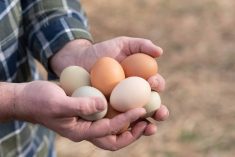I note with interest that the organization formerly known as the Western Canadian Wheat Growers Association has picked a venue for its next annual convention. I mean “with interest” as in “I’ll be interested to see if they get the same blowback they got 25 years ago, but I’m betting not.”
The group, which recently tightened up its moniker to the Wheat Growers Association, put out an invite to its members last month for “Bridging Borders: Advancing Agriculture and Trade,” an event to be held over the first week of February at the Ocean Riviera Paradise, a resort on Mexico’s Yucatan Peninsula just up the road from Playa del Carmen.
To be clear, the Wheat Growers regularly change up the venues for their annual gatherings, including centres across the group’s Prairie catchment area as well as destinations further afield, like Minneapolis and, in 2022, Nashville. You may recall the backlash, though, when the group announced back in 2000 that it would convene at an all-inclusive in Puerto Vallarta on Mexico’s west coast — which, in retrospect, tells us a lot about a very specific time in the history of Prairie farming.
Read Also

Gentle treatments for pain in the neck
Heading toward year-end, people unknowingly tense up against the cold and busyness, causing neck pain that can often be treated with appropriate support and gentle mobility, athletic therapist Kathlyn Hossack says.
At the turn of the millennium, ag groups and provincial governments were publicly calling for up to 10 figures in ad hoc federal farm aid. And as newspapers such as the National Post and op-ed and letter writers of the day noted, a clutch of Prairie farmers taking a winter trip to Mexico — something out of reach, then as now, for many Canadian citizens not actively seeking federal bailouts — was not a good look.
“How can we go cap in hand to Ottawa or drive down [Regina’s] Albert Street with our tractors and then retreat to the tropics to debate these issues?” one Saskatchewan farm couple wrote to The Western Producer at the time.
Fair point. That said, if hashtags or even Twitter had existed back then, #NotAllFarmers would surely have applied to the Wheat Growers, who often positioned themselves a band apart from most general farm groups, whether the non-farming public was aware of those differences or not.
Besides, not very much later, the term “ad hoc payment” would be largely wiped from Canadian farmers’ business plans anyway, as the federal government of the day launched the Agricultural Policy Framework, with its evolving income stabilization plan and much more targeted approach to farm disaster aid.
By comparison, what are farmers’ demands of the taxpayer these days? Of course most groups, the Wheat Growers included, would like a further carve-out from the carbon tax on farm fuels. Given the available energy options for this line of work, it’s not as difficult to build a solid business case for those additional exemptions — nor is it impossible to make such a case to those in the general public who don’t get such a break, or any of the fuel tax breaks farmers already have.
For all that hasn’t changed in the past 25 years, that much has changed in farming.
Above all else, though, let’s not ignore what’s changed the least. The total group-rate cost to attend this event (or any all-inclusive palm-tree-adjacent convention) when compared to most destinations within Canada, underscores the dilemma facing any of us who need or want to travel, whether it’s domestically or internationally, for business or margaritas.
Rick Mercer, in December 1993, put the problem most eloquently: “’Tis the season to ponder why it is that, for the cost of flying five feet within Canada, you can fly to Florida, get a hotel, a rental car, and free drinks for a week.”
Then as now.
Duty bound
Another thing that hasn’t changed over time: China’s capacity to push back on a perceived diplomatic jab. China’s commerce ministry is now running an anti-dumping investigation into Canadian canola, recoiling at Ottawa’s stated plan to introduce tariffs of 100 per cent on imports of Chinese-made electric vehicles (EVs) and 25 per cent on Chinese steel and aluminum.
The jury’s out, though, on how much China’s move will actually harm Canada’s canola sector this time. The sector is in a much different competitive space, compared to when China blocked Viterra and Richardson product back in 2019.
On top of whatever effect on canola values, though, there remains the effect of Canada’s tariffs here at home — making it more difficult for Canadian consumers to afford EVs, and raising costs for any domestic businesses that might rely on Chinese steel imports.
It’s a frustrating cycle, to say the least. Canada has invested heavily in building a domestic EV industry, and doesn’t want to lose that nest egg to what it calls an “intentional, state-directed policy of overcapacity and lack of rigorous labour and environmental standards” overseas — but Canada risks fallout and backlash with any response.
Ottawa’s 35 per cent tariff on imports of Russian fertilizers — which was levied to try and hit Moscow where it hurts after the invasion of Ukraine, but also piled costs onto farmers in Canada’s East — landed the same way. What happens is, Canada gets caught in a spot where it must take action in a tangible, consequential way. That, or do nothing — which really is not an option.
For your thoughts on other, better ways Canada could take action in cases like these, drop us a line.
















